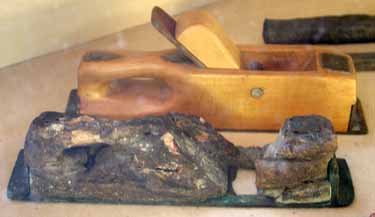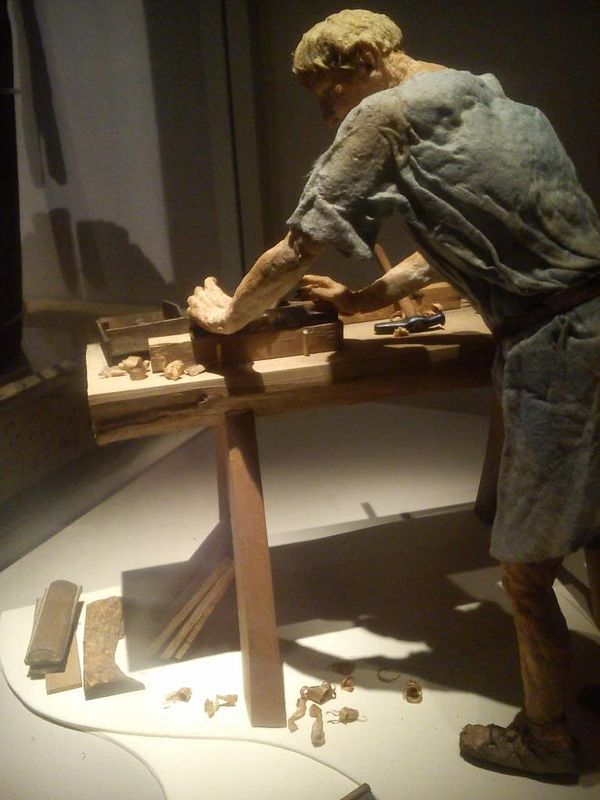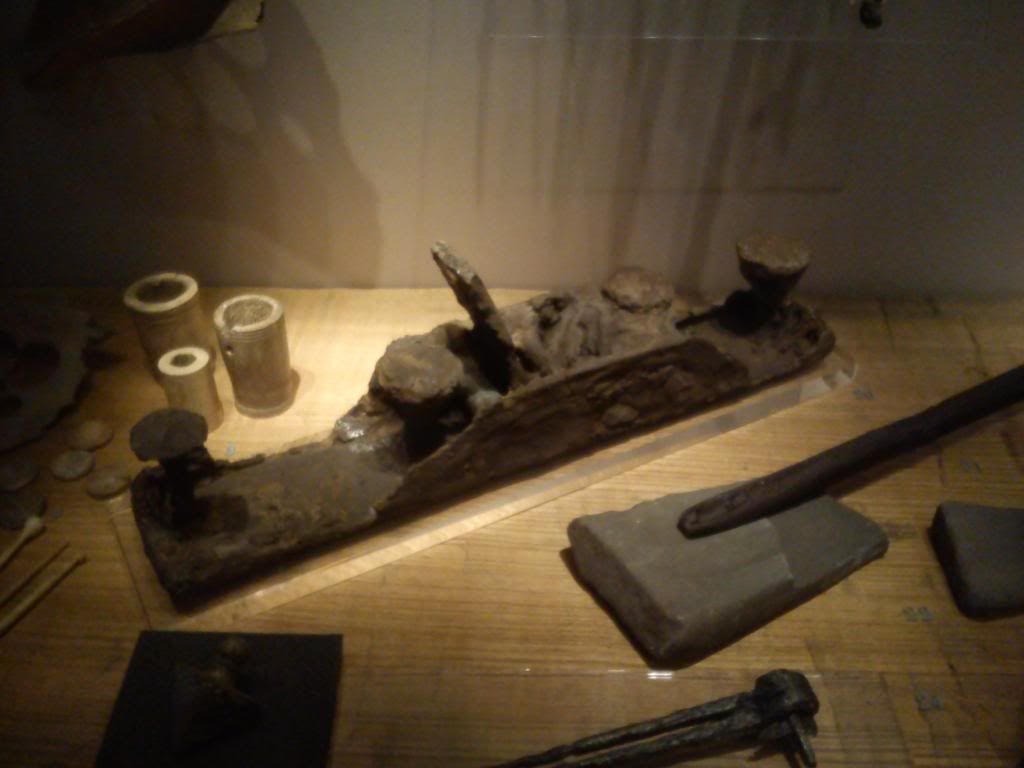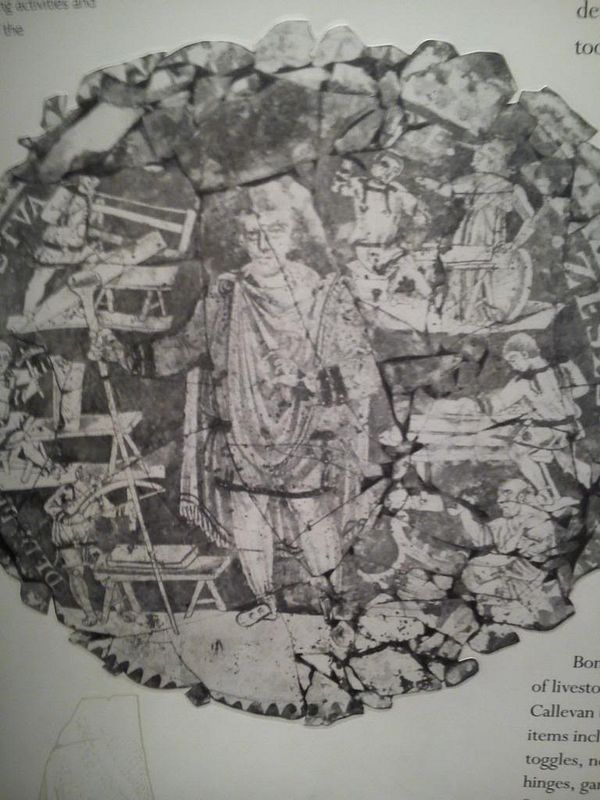You are using an out of date browser. It may not display this or other websites correctly.
You should upgrade or use an alternative browser.
You should upgrade or use an alternative browser.
Silchester plane
- Thread starter JIJ
- Start date

Help Support UKworkshop.co.uk:
This site may earn a commission from merchant affiliate
links, including eBay, Amazon, and others.
It's brilliant isn't it? All the sophistication of a current model by LN or Veritas, thousands of years ago.
Put back the missing wooden parts and you could pick it up and use it. I visited when I was last in Reading, with an hour or so between trains.
The Romans had moulding planes too - there's a Roman period Egyptian door in the Bristol museum with stuck mouldings round it which would pass for Victorian.
Put back the missing wooden parts and you could pick it up and use it. I visited when I was last in Reading, with an hour or so between trains.
The Romans had moulding planes too - there's a Roman period Egyptian door in the Bristol museum with stuck mouldings round it which would pass for Victorian.
RogerP
Established Member
It's amazing just what the Romans (and concurrent civilisations) had and achieved. Obvious they didn't have power such as steam, gas, electricity etc. (they had oxen, horses and slaves instead), but their life was in many ways very similar to ours now.
I've just been reading about their marriage, divorce and women's rights laws. It could have been today not 20 centuries ago!
I've just been reading about their marriage, divorce and women's rights laws. It could have been today not 20 centuries ago!
Living in Hampshire it's a bit annoying that the plane is residing in Reading (Berkshire) as Silchester is a Hampshire village.
But I know that Reading University did most of the excavating. I suppose finders keepers. The land was owned by the Duke of Wellington's estate.
Rod
But I know that Reading University did most of the excavating. I suppose finders keepers. The land was owned by the Duke of Wellington's estate.
Rod
Phil Pascoe
Established Member
Five minutes on a hollow oilstone and it'll be ready to go.
Cheshirechappie
Established Member
Looks like a Bedrock with a high-angle frog, too. Them Romans knew a thing or two about bench planes....

£19.27 (£3.85 / count)
£19.99 (£4.00 / count)
Stealth Lite Pro FFP3 Face Masks UK Certified Dust Mask. 99.99% particle filtration, air filter reusable face mask. FFP3 Mask -7 day use per Construction, Woodworking, DIY and Welding Mask
Amazon.co.uk

£12.50 (£1.25 / count)
£14.45 (£1.44 / count)
JSP M632 FFP3moulded Disposable Dustmask (Box of 10) One Size suitable for Construction, DIY, Industrial, Sanding, dust protection 99 Percent particle filtration Conforms and Complies to EN 149
Amazon.co.uk

£17.99 (£1.80 / count)
£27.44 (£2.74 / count)
3M 8822 Disposable-fine dust mask FFP2 (10-pack)
Amazon.co.uk

£13.99 (£2.80 / count)
VEVOX® FFP1 Dust Mask - Set of 5 - Valved Face Masks - Respirator - Protection e.g. for Construction, Building Work, Sanding, Woodworking, Fine Dusts, Aersoles or Particles
SLSK Ventures GmbH (UK)
RogerP":k35qc71h said:Obvious they didn't have power such as steam, gas, electricity etc. (they had oxen, horses and slaves instead), but their life was in many ways very similar to ours now.
Well, I would say life during that time was very different, but it just shows that a plane is basically a very simple tool that has existed for a long time, much like a hammer, knife, plough etc.
Vann
Established Member
Bedrock :!: Didn't Barney Rubble have one of those? This could pre-date the Romans :mrgreen:Cheshirechappie":1tbj1e78 said:Looks like a Bedrock....
Cheers, Vann.
jimi43
Established Member
Some nice box infills and a quick wipe over with citric acid and that would be ready to rock and roll..
I wonder if anyone is interested in doing a repro?
Any takers?
Jimi
I wonder if anyone is interested in doing a repro?
Any takers?
Jimi
My first thought was why hadn't the museum had a repro made. It would surely be of interest to have an "as new" model standing next to the original.jimi43":sns9z36g said:Some nice box infills and a quick wipe over with citric acid and that would be ready to rock and roll..
I wonder if anyone is interested in doing a repro?
Any takers?
Jimi
I'm sure I've seen pictures of a copy, possibly in an old Woodworker magazine, but can't remember where or find it easily. I agree that a complete copy would help make the exhibit more intelligible to non-woodworkers.
I'm not offering, mind!
I'm not offering, mind!
jimi43
Established Member
AndyT":1kwan00m said:I'm sure I've seen pictures of a copy, possibly in an old Woodworker magazine, but can't remember where or find it easily. I agree that a complete copy would help make the exhibit more intelligible to non-woodworkers.
I'm not offering, mind!
Ok...I can see the seeds of a fun project here....
Can we see if we can get some drawings and if a copy was made...I'm sure you can find it Prof!!! 8)
Jimi
JimB
Established Member
jimi43":2mp0exvt said:AndyT":2mp0exvt said:I'm sure I've seen pictures of a copy, possibly in an old Woodworker magazine, but can't remember where or find it easily. I agree that a complete copy would help make the exhibit more intelligible to non-woodworkers.
I'm not offering, mind!
Ok...I can see the seeds of a fun project here....
Can we see if we can get some drawings and if a copy was made...I'm sure you can find it Prof!!! 8)
Jimi
Ok, here's a little bit more information, easy to find.
This link http://www.kentarchaeology.org.uk/Research/Pub/ArchCant/Vol.073 - 1959/11/196-201.htm leads to an article by Bill Goodman (a well-known name in the world of planes!) and G Dunning, which describes an Anglo-Saxon plane found at Sarre, in Kent and compares it to other ancient planes, including the Silchester one.
The reproduction I was thinking of is probably this one, which is shown alongside the Sarre plane, in the museum at Maidstone, handily placed for any woodworkers based in the "Garden of England!"

The article does also include this line drawing of the Silchester plane as it might have been when complete, which also appears in Goodman's book on the History of Woodworking Tools:

I can't find dimensions on line, but in his book, Goodman argues that the Silchester plane would have only had one hand grip, at the rear, noting that the space between the rear rivets is 3 3/8" whereas at the front there is too small a gap, of only 2 3/4".
He helpfully suggests how the plane could have been made:
"The wooden block is first prepared to size, the mouth cut out, and drilled to take the vertical rivets. This is fixed to the iron sole, and finally the side plates are riveted in position, the handle slotted out, and the whole filed and smoothed to shape."
I expect the Reading museum could provide measurements if they were offered a reproduction to put on display, but I don't think they would have the budget to commission one.
PS - JimB - the Dartmouth link you found is a drawing of another Roman plane found at St Albans, which is of simpler construction without iron side plates, and with room for a hand grip at the front.
JimB
Established Member
Andy, oops saw the Silchester plane on the same page and didn't look too closely.
JIJ
Established Member

The museum also had a tiny display set up showing a model of the plane in use. You have to look through a peephole to view so was difficult to photograph but it may have some clues for you. It was the bench that surprised me. It is similar to one Roy Underhill made, I think it was French, had splayed legs.
James
JIJ
Established Member
JIJ
Established Member
It must only be an inch long,I'm sure they'd be very grateful for a full size one.... 
Ok!
Here are the dimensions for anyone wanting to have a go:
Silchester (Calleva), plane, iron sole, four rivets, side plates, Reading Museum, inv. 07490. 34 cm long by 5.8 cm wide by 6 cm high; iron 3.8 cm wide, rake 65 degrees.
Here are the dimensions for anyone wanting to have a go:
Silchester (Calleva), plane, iron sole, four rivets, side plates, Reading Museum, inv. 07490. 34 cm long by 5.8 cm wide by 6 cm high; iron 3.8 cm wide, rake 65 degrees.
Similar threads
- Replies
- 0
- Views
- 144





























